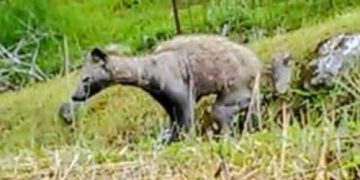A homeowner in San Manuel, Arizona, came home after work to find a furry creature in her dog’s bed – but it wasn’t a pet. It was a bobcat, believed to have come through the home’s unlocked doggie door.
The homeowner snapped a photo of the bobcat lounging in the bed and the Arizona Game and Fish Department shared the image on Twitter, warning residents not to handle wildlife like this themselves.
Officers with the department did arrive at the scene, but the bobcat had already escaped when they arrived.
A bobcat lounges on a dog bed in San Manuel home Mon. The homeowner, who found it upon returning from work, suspects it entered through an unlocked doggie door. The bobcat escaped before an officer arrived. Don’t handle entrapped/hurt wildlife yourself. Call 623-236-7201 ASAP. pic.twitter.com/zcQFD4m08h
— AZ Game & Fish Dept (@azgfdTucson) March 7, 2023
There did not appear to be a dog in the bed – just a blanket. These animals, however, are dangerous to small pets like dogs and birds.
Bobcats, which have tan coats and dark spots and look like small mountain lions, are common in all areas of Arizona, according to the department. They are prevalent in the Sonoran desert but also move to the outskirts of towns and cities, where they may find food.
They also live in many different habitats across the U.S. – from northern forests to coastal swamps in the Southeast and deserts in the Southwest, according to the Smithsonian’s National Zoo and Conservation Biology Institute. And according to the International Society for Endangered Cats Canada, bobcats live in every U.S. state except Delaware.
They are protected in 10 states, where hunting this species is regulated. While they are still often hunted for their skins, the change and loss of their habitats and being killed by farmers and ranchers is their main threat, according to the society.
They can be hunted in Arizona with a valid hunting license, according to the department.
These animals usually grow to the size of a small to medium dog – 12 to 30 pounds, and up to 24 inches tall and 36 inches long.
They usually walk around during sunrise or sunset and are often found in backyards, where they could find food like birds, rodents and even unattended small pets.
While they’re normally alone, they can travel with their families and mates and defend about 12-square-mile territories and are often territorial – they often return to the same areas, even if captured and relocated. Therefore, removing things that attracted them to an area – like food – is key to preventing their return.
The department advises people who see bobcats near their homes not to panic, as they usually don’t attack people. However, a bobcat with rabies may attack.
If a bobcat appears to be hyperactive or bites a person, there is cause for concern and animal control or the fish and game department should be called. If you are attacked, you should fight back.
The department also advises homeowners keep small pets protected inside or on leashes while outside – because even in an enclosed yard, they are not safe, as bobcats can jump up to 12 feet and over a fence. They also say not to feed the animals, because it could make them too comfortable with humans.




















